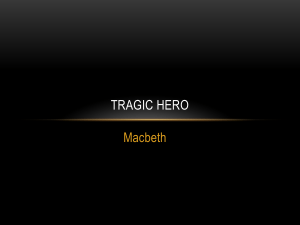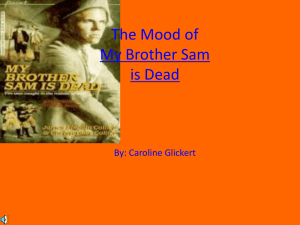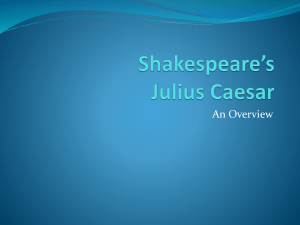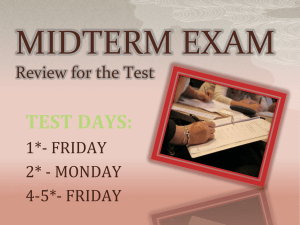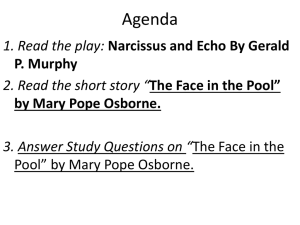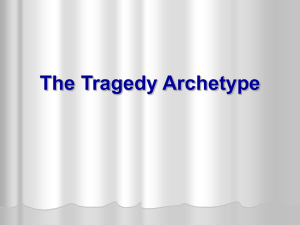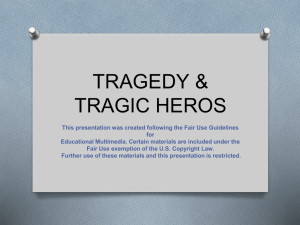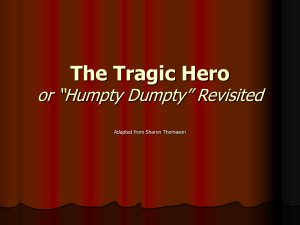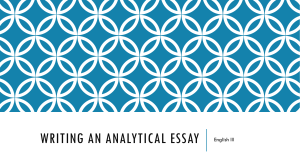The Hero and the Tragic Hero
advertisement
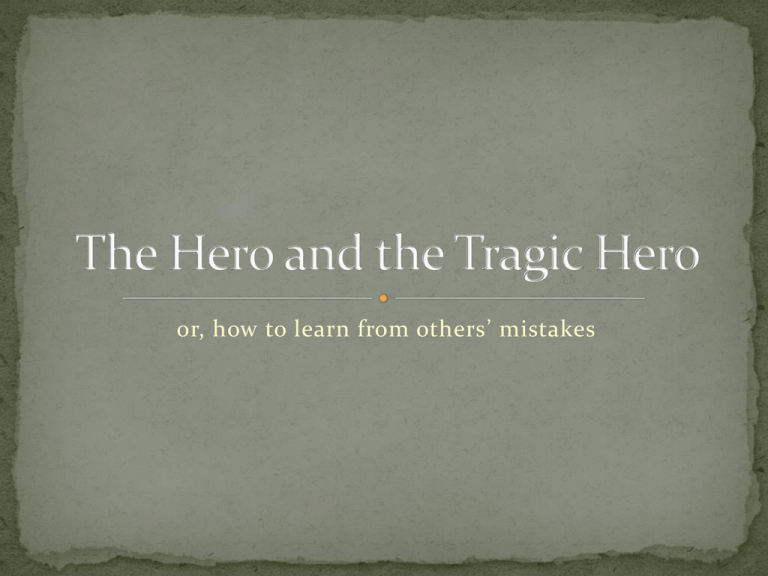
or, how to learn from others’ mistakes Joseph Campbell found that every culture has its stories of heroes. The structures of these tales are often strikingly similar between one culture and another. The Hero follows a certain, structured path in order to fulfill their destiny. 1. Heroes are introduced in the ORDINARY WORLD, a place that is comfortable-but-boring, where 2. they receive the CALL TO ADVENTURE. 3. They are RELUCTANT at first or REFUSE THE CALL, but… 4. …are encouraged by a MENTOR, who gives them an SPECIAL ITEM or ANCIENT WEAPON, to 5. CROSS THE FIRST THRESHOLD and enter the SPECIAL WORLD where 6. they encounter TESTS, ALLIES, AND ENEMIES. 7. As they APPROACH THE INMOST CAVE, they prepare for battle, thereby crossing a SECOND THRESHOLD. 8. At the Inmost Cave, they endure the ORDEAL. 9. They then take possession of their REWARD and… 10. …are pursued on THE ROAD BACK to the Ordinary World. 11. They cross the third threshold, experience a RESURRECTION, and are transformed by the experience. 12. They RETURN WITH THE ELIXIR, a reward or treasure to benefit the Ordinary World. In short? The lack of a happy ending... but, of course, it’s never as simple as that. The long (more accurate) version? The Tragic Hero follows a similar path as the Hero, but will not “Return with the Elixir” The Tragic Hero starts off at a high or exalted position (such as nobility), and experiences a Fall. A Fatal Flaw – also called “Hamartia” – leads to his fall. The Tragic Hero experiences “Catharsis,” a new understanding/realization about the world… right before his Fall. The traditional Tragic Hero comes from a position of Nobility, such as a king, prince, millionaire, or knight. The authors of modern tragedies play with this idea of nobility, changing the literal definition into a more figurative meaning. Tragic Heroes have some personality trait that might seem admirable in small doses… but the tragic hero takes things a little too far. Traits that might become “fatal flaws” include: pride, ambition, greed… or even love. Right before their Fall, the Tragic Hero (and the audience/reader) experiences Catharsis – a sudden understanding of their folly. Catharsis keeps the audience/reader from a sense of hopelessness – after all, we learned something from the Tragic Hero’s mistakes. In order for the Tragic Hero’s journey to be complete, they must experience a Fall – they either lose all their power, their prestige, their money, the object(s) of their affection… or their life. If they didn’t have a Fall, they would be just another Hero… and we wouldn’t learn anything from their mistakes! Tragic Heroes have deep vices and can truly sin, while we know that flawed heroes are always "the good guys" no matter what they do. Tragic heroes: Hamlet, Romeo, Anakin Skywalker, Willy Loman. Flawed hero: Jack Bauer. The “flawed” Hero will always come out on top, always win the day, but the tragic hero will have a major downfall. If Willy Loman is the “Tragic Hero” of Death of a Salesman, how might he fulfill the qualification of “high or exalted” position? The guy ain’t exactly a king… What might be Willy Loman’s Tragic/Fatal Flaw(s)? Explain your reasoning. What realization (Catharsis) do you think it would be important for Willy to experience before his Fall? In other words, what do you think Willy should learn about life by the end of the play? Are there any other characters in the play who might reasonably be seen as “Tragic Heroes”? Explain your reasoning. … this video contains a lot of information, with examples: http://www.youtube.com/watch?v=SB_Q1gFsvIw
